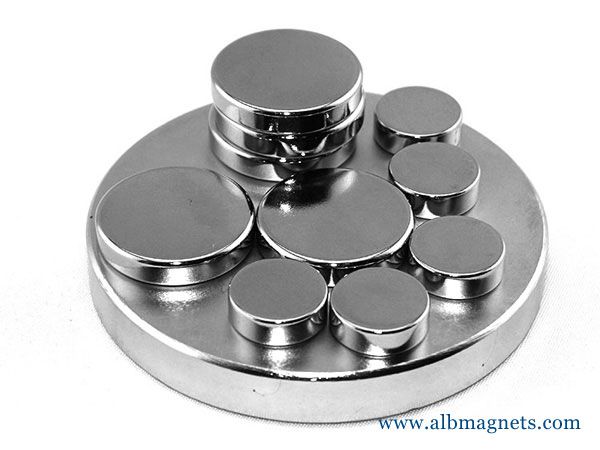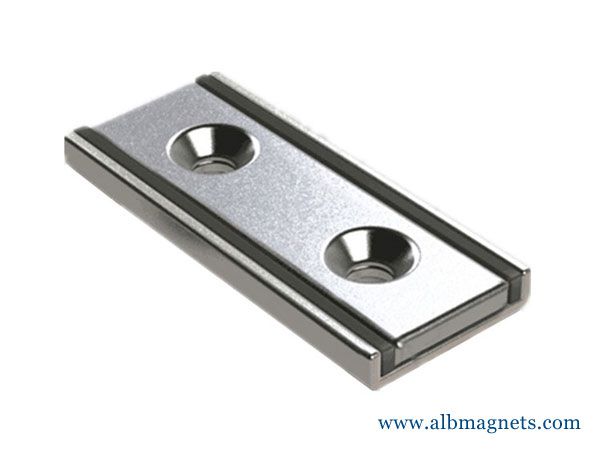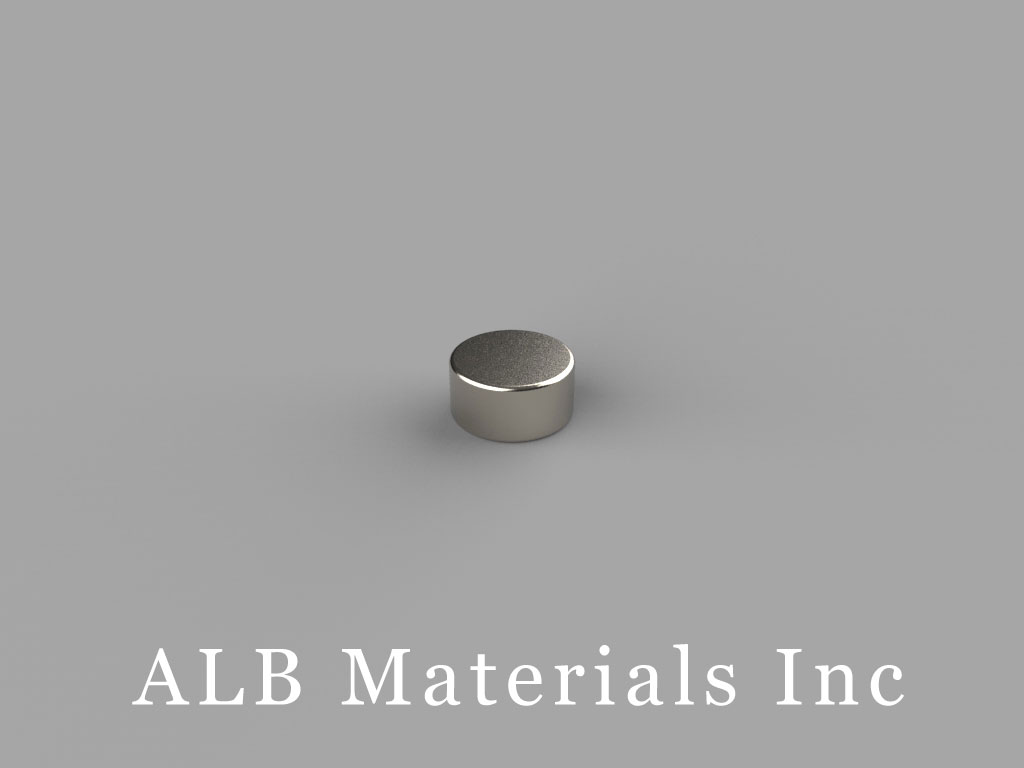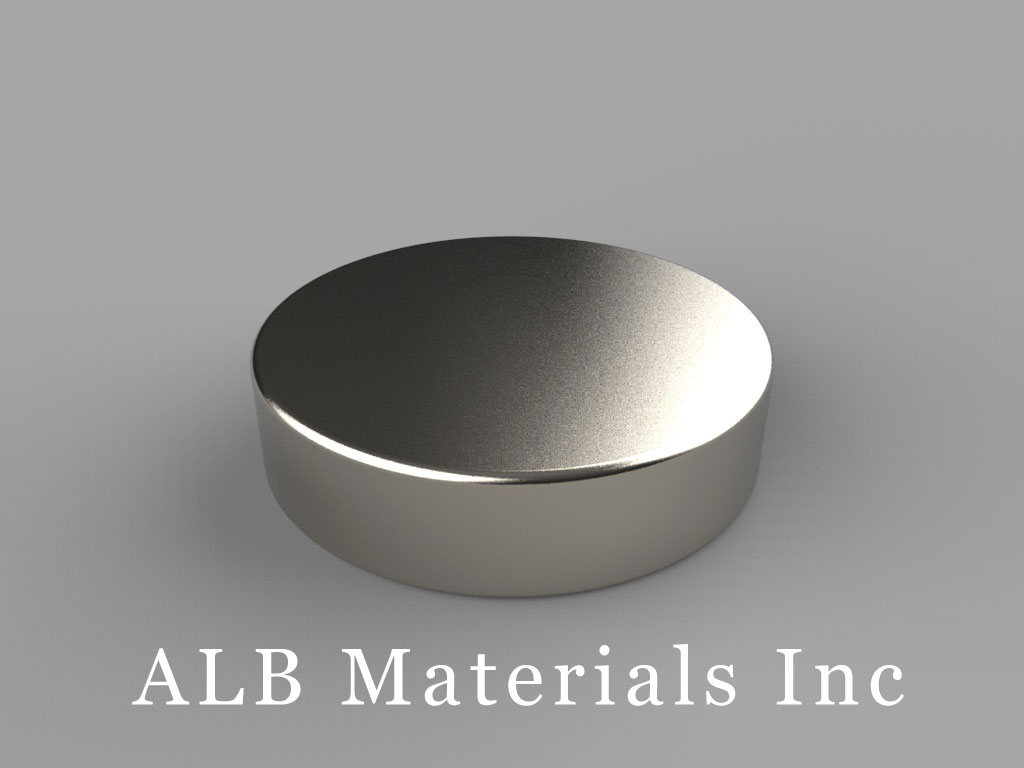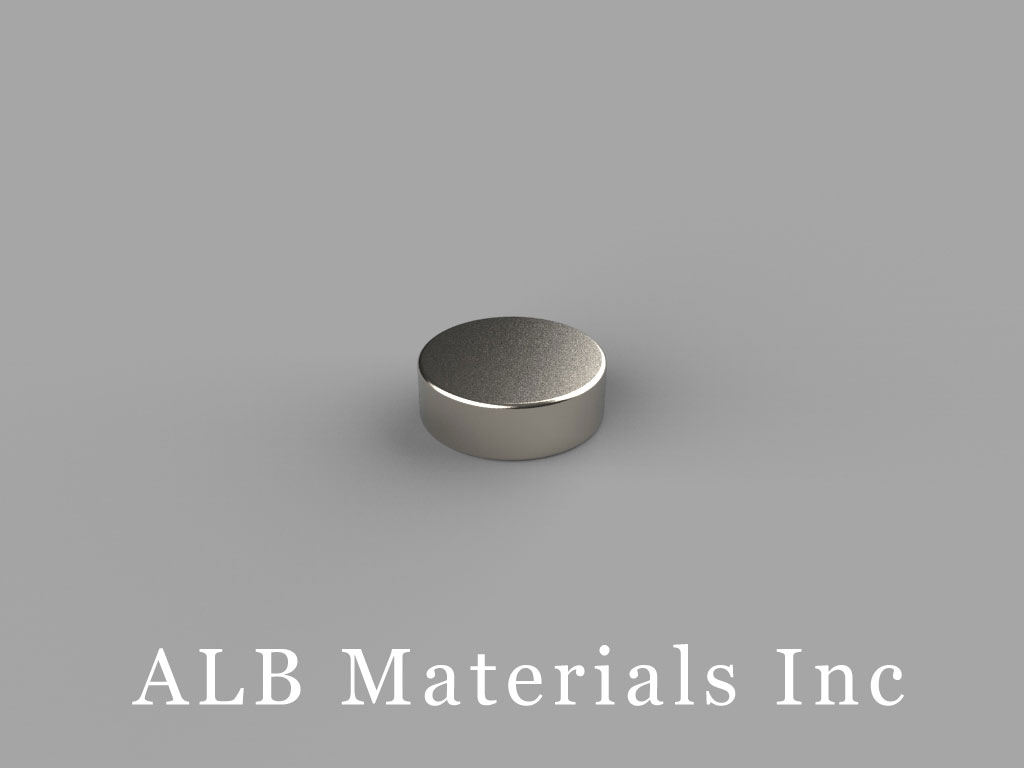401 Ryland St. Ste 200-A,
Reno, NV 89502
United States
E-mail: sales@albmaterials.com
- B50x15x15mm Neodymium Magnet, 50 x 15 x 15mm Block Magnet
- DD1 Neodymium Magnets, 13/16 inch dia. x 1/16 inch thick
- B25x8x5mm Neodymium Magnet, 25 x 8 x 5mm Block Magnet
- MM-B-48 Metric Mounting Magnets
- DH21 Neodymium Magnets, 2/10 inch dia. x 1/16 inch thick
- DH16 Neodymium Magnets, 1/10 inch dia. x 3/8 inch thick
- MM-C-75 Metric Mounting Magnets
- R-OD16.6H5ID3-N48 Neodymium Magnet, OD16.6xID3x5mm Ring Magnet
- D-D23.3H20-N48M Neodymium Magnet, 23.3x20mm Disc Magnet
- D54-N52 Neodymium Magnets, 5/16 inch dia. x 1/4 inch thick
- DA2SH Neodymium Magnets, 5/8 inch dia. x 1/8 inch thick
- BY0Y0C Neodymium Magnets, 2 inch x 2 inch x 3/4 inch thick
- D28-N52 Neodymium Magnets, 1/8 inch dia. x 1/2 inch thick
- C-D6H10-N50 Neodymium Magnet, 6x10mm Cylinder Magnet
- RC86 Neodymium Magnets, 3/4 inch od x 1/2 inch id x 3/8 inch thick
- B-W7H3L7-D3.5-N35 Neodymium Magnet, 7x7x3mm with D3.5mm hole Block Magnet
3 Properties Of A Magnet
3 properties of a magnet: The three properties that all magnets have are that they all attract certain metals, they have north and south poles, and two of the same poles will repel each other, while opposite poles will be attracted to each other.
Basic properties of magnets
1. The properties of magnets: magnets are magnetic and can attract iron objects.
2.Magnets have magnetic poles, and each magnet has two magnetic poles, N pole and S pole, which exist in pairs.
3. Temporary magnets and permanent magnets: When ferromagnetic materials are magnetized, they are easy to lose their magnetic properties and are called temporary magnets (for example iron); when ferromagnetic materials are magnetized, they are not easy to lose magnetism The nature of it is called a permanent magnet (for example steel).
4. When two magnets are close to each other, the same magnetic poles will repel each other and push away, and different magnetic poles will attract and stick to each other. So: the same poles repel each other and the different poles attract.
Frequently Asked Questions on Magnets & Magnetics
Get answers to frequently asked questions about magnet basics, magnetism.
Here are the three important properties that characterize magnets.
How permanent is a magnet’s strength?
If stored away from factors that adversely affect the magnet such as power lines, other magnets, high temperatures, etc., a magnet will retain its magnetism essentially forever.
What might affect a magnet’s strength?
Factors that can affect a magnet's strength include:
Heat
Strong electrical currents in close proximity to the magnet
Other magnets in close proximity to the magnet
Neo magnets will corrode in high humidity environments unless they have a protective coating.
Shock and vibration do not affect modern magnet materials, unless sufficient to physically damage the material.
Will magnets lose their power over time?
Modern magnet materials do lose a very small fraction of their magnetism over time.
With samarium cobalt magnets, for example, this has been shown to be less than 1% over a period of ten years.
Which are the strongest magnets?
The most powerful magnets available today are the rare- earth types.
Of the rare-earths, neodymium magnets are the strongest.
However, at elevated temperatures (of approximately 150°C and above), samarium cobalt magnets can be stronger than neo magnets, depending on the magnetic circuit.
What are superconductors?
These are the strongest magnets.
They don't need a metal core at all, but are made of coils of wire made from special metal alloys which become superconductors when cooled to very low temperatures.
Can I make a magnet that I already have stronger?
Once a magnet is fully magnetized, it's "saturated" and cannot be made any stronger.
In that sense, magnets are like buckets of water: once they are full, they can't get any "fuller".
Can a magnet that has lost its magnetism be re-magnetized?
Provided that the material has not been damaged by extreme heat, most magnets can be re-magnetized back to their original strength.
How do you measure the strength or power of a magnet?
Most commonly, Gaussmeters, magnetometers, or pull-testers are used to measure the strength of a magnet.
Gauss meters measure the strength in Gauss;
Magnetometers measure in Gauss or arbitrary units (making it easy to compare one magnet to another);
pull-testers measure pulls in pounds, kilograms, or other force units.
Helmholtz Coils, search coils, and parameters are also used to make sophisticated measurements of magnets.
contact us if you are interested in more information regarding these or to place an order.
If I have a neo magnet with a Br of 12,300 Gauss, will I be able to measure 12,300 Gauss on its surface?
The Br value is measured under closed-circuit conditions.
A closed-circuit magnet is not of much use.
In practice, you will measure a field that is less than 12,300 Gauss close to the surface of the magnet.
The actual measurement will depend on whether the magnet has any steel attached to it, how far away from the surface you make the measurement, and the size of the magnet (assuming that the measurement is being made at room temperature).
For example, a 1" diameter Grade 35 neodymium magnet that is ¼" long will measure approximately 2,500 Gauss when 1/16" away from the surface, and 2,200 Gauss when 1/8" away from the surface.
What is the strength of the earth’s magnetic field?
The surface field strength of the earth is about 0.5 gauss, but it varies by as much as 10% depending on the strength of the crustal field.
A range from 0.85 to 0.45 can be found across the globe.
Geomagnetic storms can cause changes of between 1% to 5% that last from a few hours to a full day.
How does a magnet’s strength drop off over distance?
The strength of a magnetic field drops off more or less exponentially over distance.
Magnetic Fields and Magnetic Field Lines
Define the magnetic field and describe the magnetic field lines of various magnetic fields.
Einstein is said to have been fascinated by a compass as a child, perhaps musing on how the needle felt a force without direct physical contact.
His ability to think deeply and clearly about action at a distance, particularly for gravitational, electric, and magnetic forces, later enabled him to create his revolutionary theory of relativity.
Since magnetic forces act at a distance, we define a magnetic field to represent magnetic forces.
The pictorial representation of magnetic field lines is very useful in visualizing the strength and direction of the magnetic field.
As shown in [link], the direction of magnetic field lines is defined to be the direction in which the north end of a compass needle points.
The magnetic field is traditionally called the B-field.
Magnetic field lines are defined to have the direction that a small compass points when placed at a location.
(a) If small compasses are used to map the magnetic field around a bar magnet, they will point in the directions shown: away from the north pole of the magnet, toward the south pole of the magnet.
(Recall that the Earth’s north magnetic pole is really a south pole in terms of definitions of poles on a bar magnet.) (b) Connecting the arrows gives continuous magnetic field lines.
The strength of the field is proportional to the closeness (or density) of the lines.
(c) If the interior of the magnet could be probed, the field lines would be found to form continuous closed loops.
Small compasses used to test a magnetic field will not disturb it.
(This is analogous to the way we tested electric fields with a small test charge.
In both cases, the fields represent only the object creating them and not the probe testing them.) [link] shows how the magnetic field appears for a current loop and a long straight wire, as could be explored with small compasses.
A small compass placed in these fields will align itself parallel to the field line at its location, with its north pole pointing in the direction of B.
Note the symbols used for the field into and out of the paper.
Small compasses could be used to map the fields shown here.
(a) The magnetic field of a circular current loop is similar to that of a bar magnet.
(b) A long and straight wire creates a field with magnetic field lines forming circular loops.
(c) When the wire is in the plane of the paper, the field is perpendicular to the paper.
Note that the symbols used for the field pointing inward (like the tail of an arrow) and the field pointing outward (like the tip of an arrow).
Making Connections: Concept of a Field
A field is a way of mapping forces surrounding any object that can act on another object at a distance without an apparent physical connection.
The field represents the object generating it.
Gravitational fields map gravitational forces, electric fields map electrical forces, and magnetic fields map magnetic forces.
Extensive exploration of magnetic fields has revealed a number of hard-and-fast rules.
We use magnetic field lines to represent the field (the lines are a pictorial tool, not a physical entity in and of themselves).
The properties of magnetic field lines can be summarized by these rules:
The direction of the magnetic field is tangent to the field line at any point in space.
A small compass will point in the direction of the field line.
The strength of the field is proportional to the closeness of the lines.
It is exactly proportional to the number of lines per unit area perpendicular to the lines (called the areal density).
Magnetic field lines can never cross, meaning that the field is unique at any point in space.
Magnetic field lines are continuous, forming closed loops without beginning or end.
They go from the north pole to the south pole.
The last property is related to the fact that the north and south poles cannot be separated.
It is a distinct difference from electric field lines, which begin and end on the positive and negative charges.
If magnetic monopoles existed, then magnetic field lines would begin and end on them.
Magnetic fields can be pictorially represented by magnetic field lines, the properties of which are as follows:
The field is tangent to the magnetic field line.
Field strength is proportional to the line density.
Field lines cannot cross.
Field lines are continuous loops.
Conceptual Questions
Explain why the magnetic field would not be unique (that is, not have a single value) at a point in space where magnetic field lines might cross.
(Consider the direction of the field at such a point.)
List the ways in which magnetic field lines and electric field lines are similar.
For example, the field direction is tangent to the line at any point in space.
Also, list the ways in which they differ.
For example, electric force is parallel to electric field lines, whereas magnetic force on moving charges is perpendicular to magnetic field lines.
Noting that the magnetic field lines of a bar magnet resemble the electric field lines of a pair of equal and opposite charges, do you expect the magnetic field to rapidly decrease in strength with distance from the magnet? Is this consistent with your experience with magnets?
Is the Earth’s magnetic field parallel to the ground at all locations? If not, where is it parallel to the surface? Is its strength the same at all locations? If not, where is it greatest?
Glossary
the representation of magnetic forces
B-field
another term for magnetic field
magnetic field lines
the pictorial representation of the strength and the direction of a magnetic field
the direction of magnetic field lines
the direction that the north end of a compass needle points
Magnetic Properties
To understand the difference between Ferromagnetism, paramagnetism, and diamagnetism
To identify if a chemical will be paramagnetic or diamagnetic when exposed to an external magnetic field
The magnetic moment of a system measures the strength and the direction of its magnetism.
The term itself usually refers to the magnetic dipole moment.
Anything that is magnetic, like a bar magnet or a loop of electric current, has a magnetic moment.
A magnetic moment is a vector quantity, with a magnitude and a direction.
An electron has an electron magnetic dipole moment, generated by the electron's intrinsic spin property, making it an electric charge in motion.
There is much different magnetic behavior including paramagnetism, diamagnetism, and ferromagnetism.
An interesting characteristic of transition metals is their ability to form magnets.
Metal complexes that have unpaired electrons are magnetic.
Since the last electrons reside in the d orbitals, this magnetism must be due to having unpaired d electrons.
The spin of a single electron is denoted by the quantum number \(m_s\) as +(1/2) or –(1/2).
This spin is negated when the electron is paired with another but creates a weak magnetic field when the electron is unpaired.
More unpaired electrons increase the paramagnetic effects.
The electron configuration of a transition metal (d-block) changes in a coordination compound;
this is due to the repulsive forces between electrons in the ligands and electrons in the compound.
Depending on the strength of the ligand, the compound may be paramagnetic or diamagnetic.
Ferromagnetism (Permanent Magnet)
Ferromagnetism is the basic mechanism by which certain materials (such as iron) form permanent magnets.
This means the compound shows permanent magnetic properties rather than exhibiting them only in the presence of an external magnetic field.
In a ferromagnetic element, electrons of atoms are grouped into domains in which each domain has the same charge.
In the presence of a magnetic field, these domains line up so that charges are parallel throughout the entire compound.
Whether a compound can be ferromagnetic or not depends on its number of unpaired electrons and on its atomic size.
Ferromagnetism (a) unmagnetized material and (2) Magnetized material with corresponding magnetic fields shown.
Ferromagnetism, the permanent magnetism associated with nickel, cobalt, and iron, is a common occurrence in everyday life.
Examples of the knowledge and application of ferromagnetism include Aristotle's discussion in 625 BC, the use of the compass in 1187, and the modern-day refrigerator.
Einstein demonstrated that electricity and magnetism are inextricably linked in his theory of special relativity.
Paramagnetism (Attracted to Magnetic Field)
Paramagnetism refers to the magnetic state of an atom with one or more unpaired electrons.
The unpaired electrons are attracted by a magnetic field due to the electrons' magnetic dipole moments.
Hund's Rule states that electrons must occupy every orbital singly before any orbital is doubly occupied.
This may leave the atom with many unpaired electrons.
Because unpaired electrons can spin in either direction, they display magnetic moments in any direction.
This capability allows paramagnetic atoms to be attracted to magnetic fields.
Diatomic oxygen is a good example of paramagnetism (described via molecular orbital theory).
The following video shows liquid oxygen attracted into a magnetic field created by a strong magnet:
Paramagnetism of Liquid Oxygen
Diamagnetism (Repelled by Magnetic Field)
Molecular oxygen is paramagnetic and is attracted to is paramagnetic and is attracted to the magnet.
In contrast, molecular nitrogen has no unpaired electrons and is diamagnetic;
it is therefore unaffected by the magnet.
Diamagnetic substances are characterized by paired electrons, e.g., no unpaired electrons.
According to the Pauli Exclusion Principle which states that no two electrons may occupy the same quantum state at the same time, the electron spins are oriented in opposite directions.
This causes the magnetic fields of the electrons to cancel out;
thus there is no net magnetic moment, and the atom cannot be attracted to a magnetic field.
In fact, diamagnetic substances are weakly repelled by a magnetic field as demonstrated with the pyrolytic carbon sheet in Figure
Levitating pyrolytic carbon: A small (~6 mm) piece of pyrolytic graphite levitating over a permanent neodymium magnet array (5 mm cubes on a piece of steel).
Note that the poles of the magnets are aligned vertically and alternate (two with north facing up, and two with south facing up, diagonally).
Image used with permission from Wikipedia.
How to Tell if a Substance is Paramagnetic or Diamagnetic
The magnetic properties of a substance can be determined by examining its electron configuration: If it has unpaired electrons, then the substance is paramagnetic and if all electrons are paired, the substance is then diamagnetic.
Properties of Magnet, Fun With Magnets
Two most important properties of magnets
1) A freely suspended magnet always points in the north-south direction.
2) Like magnetic poles repel each other;
unlike magnetic poles attract each other.
A Freely Suspended Magnet Always Points in North-South Direction
If a bar magnet is freely suspended, it will swing until its one endpoints towards the north pole of the earth and the other towards the south pole of the earth.
A freely suspended magnet comes to rest always in the north-south direction.
We call it a freely suspended
magnet because it is free to move in any direction.
If we turn the magnet by hand so that it points in another direction and then leave it.
We will see that after a while the magnet comes back to its earlier position and again points in the same north-south direction.
The end of the magnet which points towards the north direction is called the north-seeking end or north pole of the magnet.
The end of the magnet which points towards the south direction is called the south-seeking end or south pole of the magnet.
It is only a freely suspended magnet (or a freely pivoted magnet) which always comes to rest along the same direction (north-south direction) even after being disturbed again and again.
The four major directions are North, South, East, and West.
These are denoted by the letters N, S, E, and W respectively.
We can have four more directions as North-East (NE), North-West (NW), South-East (SE) and South-West (SW).
North-East is midway between North and East directions.
North-West is midway between North and West directions.
South-East is midway between South and East directions.
South-West is midway between South and West directions.
The sun always rises in the morning from the East direction.
So, if we stand facing the morning sun rising from the East direction with both the arms extended on sides, then our left arm will point towards North and the right arm will point towards the South.
Finding Directions
The property of a freely suspended magnet to align itself always along the North-South of the earth is used to find directions at unknown places.
1) For centuries, travelers on land and at sea have been using this property of magnets to find directions.
2) In olden days, travelers to far off places used to carry natural magnets (which were strips of magnetite) and thread with them.
They used to find directions along their way by suspending the natural magnet with a thread.
When artificial magnets were available, an instrument (or device) called compass was
developed to find directions more conveniently.
In a compass, the magnet is not suspended from a thread.
The tiny magnet in a compass is free to turn (or rotate) on a pivot or pin.
It is called a freely pivoted magnet.
Just like a freely suspended magnet, a freely pivoted magnet also always comes to rest along the north-south direction.
1) The compass is an instrument to find the directions at a place.
The compass is based on the property of a freely pivoted magnet to align itself along the north-south direction.
2)The compass has a tiny magnet in the form of a needle that can rotate freely on a pivot (or pin).
3)The pivoted magnetic needle of the compass is enclosed in a small brass box having a glass top.
4) The compass has a circular dial with various directions marked on it.
The needle of the compass always comes to rest along the north-south direction.
5)The north pole of the compass needle is painted with a different color to distinguish it from the south pole.
6) To find the directions at a place, the compass is kept on a flat surface at that place.
The needle of compass will soon come to rest (or become stationary) along the north-south direction.
The compass is then rotated until the painted end of needle is towards N mark on the dial and the other end of needle is towards S (South) mark on the dial.
Uses of compass
1)Compass is used by soldiers in the jungle to find direction for their movement.
2)The compass is also used by sailors while at sea so as to take their ships in the right direction.
Why a freely suspended magnet (or a freely pivoted magnet) always points in the same direction : north-south direction.
Our planet earth also shows magnetism.
The earth behaves as if a giant bar magnet is buried at its centre.
It is the force exerted by the earth’s imaginary magnet which acts on a freely suspended bar magnet (or freely pivoted magnetic needle of a compass)y and makes them always point in the north-south direction.
Attraction and repulsion between magnets
Whether a magnet will attract or repel another magnet depends on which poles of the magnets are facing each other.
(1) When we place two magnets in such a way that the north pole of one magnet faces the north pole of other magnet, they repel (push away) each other.Similarly, when the two magnets are placed near each other in such a way that south pole of one magnet faces the south pole of the other magnet, even then they repel (push away) each other.
Since north-north poles and south-south poles are like poles, we can say that like poles (or similar poles) repel each other.
(2) If we place two magnets near each other in such a way that the north pole of one magnet faces the south pole of the other magnet, they attract each other (and come near to each other).Since north pole and south pole are unlike poles, we can say that unlike poles attract each other.
ACTIVITY
Let us bring the north pole of the hand-held magnet near the north pole of the suspended magnet.
We will find that the north pole of the suspended magnet moves away from the north pole of our hand-held magnet.
This means that the north pole of one magnet repels the north pole of the other magnet.
If we bring the south pole of the hand-held magnet near the south pole of the suspended magnet, even then the south pole of suspended magnet moves away showing that the south pole of one magnet repels the south pole of another magnet.
We now bring the south pole of the hand-held magnet near the north pole of the suspended magnet.
We find that the north pole of the suspended magnet moves towards the south pole of our hand-held magnet.
This means that the south pole of one magnet attracts the north pole of another magnet.
The above activity shows that:
1) N pole brought near to N pole repels.
2) S pole brought near to S pole repels.
Like magnetic poles repel each other
1) N pole brought near to S pole attracts.
2) S pole brought near to N pole attracts.
Unlike magnetic poles attract each other.
If two magnets are brought close together then like magnetic poles will repel each other and unlike magnetic poles will attract each other.
The needle of a compass always aligns itself in the same direction:north-south direction.
The needle of a compass is itself a tiny magnet (having an N-pole and an S-pole) which is free to rotate on a pivot. When another magnet is brought near a compass, then this magnet will attract or repel the magnetic needle of a compass due to which the compass needle will be disturbed from its usual north-south direction.
The compass needle will point in another direction.
If we take the magnet away from the compass, the compass needle will come back to its original north-south position.
The various devices and appliances such as mobile phones, music systems, television sets, computers, compact discs (CDs), cassettes and credit cards, etc., use magnetism for their working. So, we should keep strong magnets away from all these devices so as not to disturb their working.
Filed Under: Class 6, Fun With Magnets Tagged With Attraction and repulsion between magnets , compass , freely pivoted magnet , north-seeking end or north pole of the magnet , properties of magnet , properties of magnet class 6 , properties of magnet class 6 notes , south-seeking end or south pole of the magnet , Uses Of compass
Properties of Magnets & Electromagnets
Physics rarely feels more magical than when you first encounter a magnet as a kid.
Getting a bar magnet in science class and trying – with all your might – to push it towards the matching pole of another magnet but being completely unable to, or leaving opposing poles close to each other but not touching so you can see them creep together and eventually join.
You quickly learn that this behavior is a result of magnetism, but what really is magnetism? What’s the link between electricity and magnetism that allows electromagnets to work? Why wouldn’t you use a permanent magnet instead of an electromagnet in a metal scrap yard, for example? Magnetism is a fascinating and complicated topic, but if you just want to learn the properties of a magnet and the basics, it’s really easy to pick up.
What Are the Properties of a Magnet?
The defining properties of magnets are that they attract some materials and the opposite poles of other magnets, and repel like poles of other magnets.
So if you have two permanent bar magnets, pushing two north (or south) poles together produces a repulsive force, which gets stronger the closer the two ends are brought together.
If you bring two opposite poles together (north and south) there is an attractive force between them.
The closer you bring them together, the stronger this force is.
Ferromagnetic materials – like iron, nickel, and cobalt – or alloys containing them (such as steel) are attracted to permanent magnets, even if they aren’t producing a magnetic field of their own.
They are only attracted to the magnets, though, and they won’t be repelled unless they start producing a magnetic field of their own.
Other materials, such as aluminum, wood, and ceramics, aren’t attracted to magnets.
How Does an Electromagnet Work?
A permanent magnet and electromagnet are quite different.
Electromagnets involve electricity in a more obvious way and are essentially generated by the movement of electrons through a wire or electrical conductor.
As with the creation of magnetic domains, the movement of electrons through a wire produces a magnetic field.
The shape of the field depends on the direction in which the electrons are traveling – if you point the thumb of your right hand in the direction of the current, your fingers curl in the direction of the field.
To produce a simple electromagnet, electrical wire is coiled around a central core, usually made of iron.
When current flows through the wire, traveling in circles around the core, a magnetic field is produced, running along the central axis of the coil.
This field is present regardless of whether or not you have a core, but with an iron core, the field aligns the domains in the ferromagnetic material and thereby gets stronger.
When the flow of electricity is stopped, the charged electrons stop moving around the coil of wire, and the magnetic field disappears.
What Are the Properties of an Electromagnet?
Electromagnets and magnets have the same key properties.
The distinction between a permanent magnet and an electromagnet is essentially one in how the field is created, not the properties of the field afterward.
So electromagnets still have two poles, still attract ferromagnetic materials, and still have poles that repel others like poles and attract, unlike poles.
The difference is that the moving charge in permanent magnets is created by the movement of electrons in atoms, whereas in electromagnets it is created by the movement of electrons as part of an electrical current.
Advantages of Electromagnets
Electromagnets have many advantages, though.
Because the magnetic field is produced by the current, its characteristics can be changed by changing the current.
For example, increasing the current increases the strength of the magnetic field.
Similarly, an alternating current (AC electricity) can be used to produce a constantly changing magnetic field, which can be used to induce a current in another conductor.
For applications like magnetic cranes in metal scrap yards, the big advantage of electromagnets is that the field can be turned off with ease.
If you picked a piece of scrap metal up with a large permanent magnet, removing it from the magnet would be quite a challenge! With an electromagnet, all you have to do is stop the flow of current and the scrap metal will drop.
Magnets and Maxwell’s Laws
The laws of electromagnetism are described by Maxwell’s laws.
These are written in the language of vector calculus and require some fairly complicated mathematics to use.
However, the basics of the rules relating to magnetism can be understood without delving into the complicated mathematics.
The first law relating to magnetism is called the “no monopole law.” This basically states that all magnets have two poles, and there will never be a magnet with a single pole.
In other words, you can’t have a north pole of a magnet without a south pole, and vice-versa.
The second law relating to magnetism is called Faraday’s law.
This describes the process of induction, where a changing magnetic field (produced by an electromagnet with a varying current or by a moving permanent magnet) induces a voltage (and electric current) in a nearby conductor.
The final law relating to magnetism is called the Ampere-Maxwell law, and this describes how a changing electric field produces a magnetic field.
The strength of the field is related to the current passing through the area and the rate of change of the electric field (which is produced by electric charge carriers such as protons and electrons).
This is the law you use to calculate a magnetic field in simpler cases, such as for a coil of wire or a long straight wire.
Magnets are very useful tools that we use every day without even realizing it.
All magnets have certain scientific properties.
Here you will learn about the three main properties of magnets.
When you're watching your favorite show on television, listening to your favorite song on the radio, or talking to your friend on the phone, did you know you're using magnets? Even when you turn on the light in your bedroom, you are using a magnet that creates electricity.
Let's explore the three main properties of magnets that make them such useful tools.
What Do They Attract?
One property of magnets is the type of metal they attract or stick to.
These metals are iron, cobalt, and nickel.
Even though gold and silver are pretty metals, they are not attracted to magnets.
The large magnet at the end of this crane is picking up metal.
Opposites Attract
Magnet Girl wanted to show her powers to her friends.
She was using another magnet, but instead of it sticking to her, it acted as it wanted to get away! She couldn't figure out what she was doing wrong.
She didn't realize that magnets have two poles: a north pole and a south pole.
The poles are simply the ends of a magnet.
The same poles of two magnets will go away from, or repel, each other.
Opposite poles will stick to, or be attracted to, each other.
The ends of a magnet also have a stronger magnetic force than the middle.
Once she turned the magnet around and touched the opposite pole, she was able to show her friends her new powers!
A bar magnet showing the north and south poles.
Types, Uses, Applications of Bar Magnet
The attraction is the basic property of the magnets.
The magnet attracts metallic objects like iron, nickel, and cobalt.
But did you know metal is useful in generating electricity as well? What else can magnets do? What are the applications of magnets? Let us find out!
List of Properties of Magnet:
We already know that magnets are made up of the magnetic substance.
Magnets have certain important properties.
They are Attractive Property – Magnet attracts ferromagnetic materials like iron, cobalt, and nickel.
Repulsive Properties – Like magnetic poles repel each other and unlike magnetic poles attract each other.
Directive Property – A freely suspended magnet always points in a north-south direction.
Attractive Property
Magnets attract other magnetic substances.
This property can be demonstrated with the help of a simple activity.
The activity I: Materials needed: A bar magnet, iron filings
Method: Place the bar magnet in the heap of iron filings.
Observation: Iron filings cling to the magnet.
Also, the maximum amount of iron filings cling at the two ends of the bar magnet.
These are the poles of the magnet.
Inference: The Magnetic property of poles is more than the rest of the magnet.
Poles of the magnet are those regions where the magnetic property is the maximum.
The two poles are different.
One pole of the magnet is the North pole and the other is the South Pole.
Every magnet whether big or small has the North Pole and the South Pole.
Repulsive Properties of Magnet
Like magnetic poles repel each other and unlike magnetic poles attract each other. Property of attraction and repulsion exists between two magnets.
It can be demonstrated with the help of a simple activity.
Activity II: Materials needed: Two bar magnets
Method: Take two bar magnets.
Try to bring them close to each other in such a way that both the like poles come closer.
Now bring North pole of one magnet close to the south pole of another.
Observation: If the two poles you are trying to bring closer are the same ie.
Both are North poles or both are south poles, then the two poles will repel each other.
If you are trying to bring the opposite poles together there will be a force of attraction between the two magnets.
Inference: Like poles repel each other and unlike poles attract each other.
Directive Property of the Magnet
A freely suspended magnet always points in north-south direction This can be demonstrated with the help of a simple activity.
Activity III: Materials needed: A bar magnet, a string, a stand
Method: Take a bar magnet.
Tie it with a string from the center and hang it on the wooden stand in such a way that it can move freely.
Observation: The freely suspended magnet points in the north-south direction.
Explanation: Our planet earth also shows magnetism.
The Earth is actually a giant bar magnet with its magnetic north pole towards the Geographic South Pole and the magnetic South Pole towards the Geographic North Pole.
Hence, we can observe that the north pole of a freely suspended magnet points toward the north pole of the earth and south pole of a freely suspended magnet points towards the South Pole of the earth.
The Magnet and the Magnetic Field
A Magnet is an object that produces a Magnetic Field;
it can be formed of a permanent magnet or an electromagnet.
The word magnet comes from the Greek "magnítis líthos", which means "Magnesian Stone".
Magnesia is an area in Greece (Now Manisa, Turkey) where deposits of magnetite have been discovered since antiquity.
Magnets come in many shapes but no matter what their shapes are, each magnet has a North Pole and the South Pole.
A Magnetic Field is said to exist in a region if a (Magnetic) Force can be exerted on a Magnet.
Magnetic Field Lines (Flux Lines) are imaginary lines representing the direction and strength of the Magnetic Field.
They go from the North Pole to the South Pole outside the Magnet and go from the South Pole to the North Pole inside the Magnet.
The density of the Magnetic Field Lines is higher near the Poles, and the Magnetic Force is stronger there Figure 1.
Figure 1: The Magnetic Field created by a Magnet
A Magnet attracts or repels other Magnets, depending on their mutual orientation of North and South Poles.
When placing like Poles of two Magnets together, the Magnets repel each other, Figure 2.
Figure 2: Like poles repel each other
However, if opposite Poles are placed together, they attract each other, Figure 3.
Figure 3: Opposite poles attract each other
Aside from that, magnets attract other magnetic materials like iron, nickel, and cobalt.
The Magnetic Field exerts a Magnetic Force on these materials, Figure 4.
Figure 4: Magnetic Field Lines distribution through different materials
A Compass is a navigational instrument of finding directions on the earth.
It consists of a thin piece of a Magnet in needle shape, which is balanced on a nearly frictionless pivot point.
The Earth Geographical North Pole is actually the Magnetic South Pole, which attracts the North Pole of the Compass, making it points north.
What is Magnetism?
Magnetism is one aspect of the combined electromagnetic force.
It refers to physical phenomena arising from the force caused by magnets, objects that produce fields that attract or repel other objects.
A magnetic field exerts a force on particles in the field due to the Lorentz force, according to Georgia State University's HyperPhysics website.
The motion of electrically charged particles gives rise to magnetism.
The force acting on an electrically charged particle in a magnetic field depends on the magnitude of the charge, the velocity of the particle, and the strength of the magnetic field.
All materials experience magnetism, some more strongly than others.
Permanent magnets, made from materials such as iron, experience the strongest effects, known as ferromagnetism.
With rare exceptions, this is the only form of magnetism strong enough to be felt by people.
Magnetic fields are generated by rotating electric charges, according to HyperPhysics.
Electrons all have a property of angular momentum or spin.
Most electrons tend to form pairs in which one of them is “spin up” and the other is “spin down,” in accordance with the Pauli Exclusion Principle, which states that two electrons cannot occupy the same energy state at the same time.
In this case, their magnetic fields are in opposite directions, so they cancel each other.
However, some atoms contain one or more unpaired electrons whose spin can produce a directional magnetic field.
The direction of their spin determines the direction of the magnetic field, according to the Non-Destructive Testing (NDT) Resource Center.
When a significant majority of unpaired electrons are aligned with their spins in the same direction, they combine to produce a magnetic field that is strong enough to be felt on a macroscopic scale.
Magnetic field sources are dipolar, having a north and south magnetic pole.
Opposite poles (N and S) attract, and like poles (N and N, or S and S) repel, according to Joseph Becker of San Jose State University.
This creates a toroidal, or doughnut-shaped field, as the direction of the field propagates outward from the north pole and enters through the south pole.
The Earth itself is a giant magnet.
The planet gets its magnetic field from circulating electric currents within the molten metallic core, according to HyperPhysics.
A compass points north because the small magnetic needle in it is suspended so that it can spin freely inside its casing to align itself with the planet's magnetic field.
Paradoxically, what we call the Magnetic North Pole is actually a south magnetic pole because it attracts the north magnetic poles of compass needles.
Ferromagnetism
If the alignment of unpaired electrons persists without the application of an external magnetic field or electric current, it produces a permanent magnet.
Permanent magnets are the result of ferromagnetism.
The prefix “Ferro” refers to iron because permanent magnetism was first observed in a form of natural iron ore called magnetite, Fe3O4.
Pieces of magnetite can be found scattered on or near the surface of the earth, and occasionally, one will be magnetized.
These naturally occurring magnets are called lodestones.
“We still are not certain as to their origin, but most scientists believe that lodestone is magnetite that has been hit by lightning,” according to the University of Arizona.
People soon learned that they could magnetize an iron needle by stroking it with a lodestone, causing a majority of the unpaired electrons in the needle to line up in one direction.
According to NASA, around A.D.
1000, the Chinese discovered that a magnet floating in a bowl of water always lined up in the north-south direction.
The magnetic compass thus became a tremendous aid to navigation, particularly during the day and at night when the stars were hidden by clouds.
Other metals besides iron have been found to have ferromagnetic properties.
These include nickel, cobalt, and some rare earth metals such as samarium or neodymium which are used to make super-strong permanent magnets.
Other forms of magnetism
Magnetism takes many other forms, but except for ferromagnetism, they are usually too weak to be observed except by sensitive laboratory instruments or at very low temperatures. Diamagnetism was first discovered in 1778 by Anton Brugnams, who was using permanent magnets in his search for materials containing iron.
According to Gerald Küstler, a widely published independent German researcher and inventor, in his paper, “Diamagnetic Levitation — Historical Milestones,” published in the Romanian Journal of Technical Sciences, Brugnams observed, “Only the dark and almost violet-colored bismuth displayed a particular phenomenon in the study;
for when I laid a piece of it upon a round sheet of paper floating atop the water, it was repelled by both poles of the magnet.”
Bismuth has been determined to have the strongest diamagnetism of all elements, but as Michael Faraday discovered in 1845, it is a property of all matter to be repelled by a magnetic field.
Diamagnetism is caused by the orbital motion of electrons creating tiny current loops, which produce weak magnetic fields, according to HyperPhysics.
When an external magnetic field is applied to a material, these current loops tend to align in such a way as to oppose the applied field.
This causes all materials to be repelled by a permanent magnet;
however, the resulting force is usually too weak to be noticeable.
There are, however, some notable exceptions.
Pyrolytic carbon, a substance similar to graphite, shows even stronger diamagnetism than bismuth, albeit only along one axis, and can actually be levitated above a super-strong rare earth magnet.
Certain superconducting materials show even stronger diamagnetism below their critical temperature and so rare-earth magnets can be levitated above them.
(In theory, because of their mutual repulsion, one can be levitated above the other.)
Paramagnetism occurs when a material becomes magnetic temporarily when placed in a magnetic field and reverts to its nonmagnetic state as soon as the external field is removed.
When a magnetic field is applied, some of the unpaired electron spins align themselves with the field and overwhelm the opposite force produced by diamagnetism.
However, the effect is only noticeable at very low temperatures, according to Daniel Marsh, a professor of physics at Missouri Southern State University.
Other, more complex, forms include antiferromagnetism, in which the magnetic fields of atoms or molecules align next to each other;
and spin glass behavior, which involves both ferromagnetic and antiferromagnetic interactions.
Additionally, ferrimagnetism can be thought of as a combination of ferromagnetism and antiferromagnetism due to many similarities shared among them, but it still has its own uniqueness, according to the University of California, Davis.
Electromagnetism
When a wire is moved in a magnetic field, the field induces a current in the wire.
Conversely, a magnetic field is produced by an electric charge in motion.
This is in accordance with Faraday’s Law of Induction, which is the basis for electromagnets, electric motors, and generators.
A charge moving in a straight line, as through a straight wire, generates a magnetic field that spirals around the wire.
When that wire is formed into a loop, the field becomes a doughnut shape or a torus.
According to the Magnetic Recording Handbook (Springer, 1998) by Marvin Cameras, this magnetic field can be greatly enhanced by placing a ferromagnetic metal core inside the coil.
In some applications, direct current is used to produce a constant field in one direction that can be switched on and off with the current.
This field can then deflect a movable iron lever causing an audible click.
This is the basis for the telegraph, invented in the 1830s by Samuel F.B.
Morse, which allowed for long-distance communication over wires using a binary code based on long- and short-duration pulses.
The pulses were sent by skilled operators who would quickly turn the current on and off using a spring-loaded momentary-contact switch or key.
Another operator on the receiving end would then translate the audible clicks back into letters and words.
A coil around a magnet can also be made to move in a pattern of varying frequency and amplitude to induce a current in a coil.
This is the basis for a number of devices, most notably, the microphone.
Sound causes a diaphragm to move in an out with the varying pressure waves.
If the diaphragm is connected to a movable magnetic coil around a magnetic core, it will produce a varying current that is analogous to the incident sound waves.
This electrical signal can then be amplified, recorded or transmitted as desired.
Tiny super-strong rare-earth magnets are now being used to make miniaturized microphones for cell phones, Marsh told Live Science.
When this modulated electrical signal is applied to a coil, it produces an oscillating magnetic field, which causes the coil to move in and out over a magnetic core in that same pattern.
The coil is then attached to a movable speaker cone so it can reproduce audible sound waves in the air.
The first practical application for the microphone and speaker was the telephone, patented by Alexander Graham Bell in 1876.
Although this technology has been improved and refined, it is still the basis for recording and reproducing sound.
The applications of electromagnets are nearly countless.
Faraday’s Law of Induction forms the basis for many aspects of our modern society including not only electric motors and generators but electromagnets of all sizes.
The same principle used by a giant crane to lift junk cars at a scrap yard is also used to align microscopic magnetic particles on a computer hard disk drive to store binary data, and new applications are being developed every day.
Staff Writer Tanya Lewis contributed to this report.
Additional resources
The National High Magnetic Field Laboratory is the largest and highest-powered magnet laboratory in the world.
Researchers use the facilities for free to study materials, energy and life.
The Internet Plasma Physics Education Experience & has an interactive module about the basic concepts involved with Electricity and Magnetism.
NASA's Goddard Space Flight Center features these lessons on the " Early History of Electricity and Magnetism " and " The Exploration of the Earth's Magnetosphere ."
Part of the content in this article is reproduced from other media for the purpose of transmitting more information and does not mean that this website agrees with its views or confirms the authenticity of its content. It shall not bear direct responsibility and joint liability for the infringement of such works.
If there is any infringement, bad information, error correction, and other issues in the content of this page, please contact us at info@albmaterials.com
Link to this article: https://www.albmagnets.com/blog/3-properties-of-a-magnet.html
How to choose and buy a strong neodymium magnet? ALBMagnets is a professional company for strong magnet design and manufacturing,
providing you with reliable N35, N38, N42, N52, N42SH and other grade super neodymium magnets and SmCo rare earth magnets.









